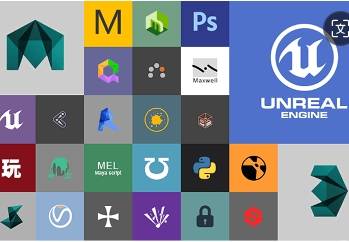Release date:2023
Author:Pixel Helmet
Skill level:Beginner
Language:English
Exercise files:Yes
For the final project of the “Imaginary Places: Draw, Paint, and Digitize on Photoshop” course, you will be encouraged to use the skills and techniques you have learned throughout the course to create your own unique imaginary place. Here are the steps you can follow:
Gather Inspiration: Take the time to gather inspiration from your surroundings, whether it’s through sketchbook sketches, textures, or experiences. Observe the details of the world around you, such as how light falls on objects, the colors of the sun, and the shadows created. Use this inspiration to fuel your creativity and come up with ideas for your imaginary place. Create a Mood Board: Use the inspiration you’ve gathered to create a mood board. This can be a collage of images, sketches, textures, and other visual elements that represent the mood, atmosphere, and style you want to convey in your imaginary place. Keep track of your progress with different pictures of each step and explain the choices you’ve made along the way. Develop Textures: Use the abstract nature of creating textures to spark new ideas for your imaginary place. Experiment with different techniques and tools in Photoshop to create unique textures that can be used in your illustrations. Create a folder to store these textures, as they can be used in your future illustrations as well. Infuse Your Imagination: Once you have gathered inspiration and created textures, it’s time to infuse your imagination into your project. Use the skills and techniques you have learned in the course, such as drawing, painting, and digitizing on Photoshop, to bring your imaginary place to life. Be creative and experiment with different styles, colors, and compositions to make your project truly unique. Document Your Process: As you work on your final project, document your process by taking pictures and explaining the choices you’ve made along the way. This will not only help you track your progress but also provide insight into your creative process, which can be helpful if you need advice or guidance from your instructor. Create a Unique Project: Whether you choose to finish the illustration you started during the course tasks or start a brand new project, make sure to create a unique project that reflects your artistic style and vision. Don’t be afraid to take risks and push your creative boundaries to make your imaginary place come to life in a way that is truly your own.By following these steps and using the skills and techniques you’ve learned in the course, you will be able to create a unique imaginary place that showcases your creativity and artistic abilities. Don’t forget to have fun and enjoy the process of bringing your imagination to life on Photoshop!
In the course “Learn Game Development Using Unreal Engine 5,” you will learn the following:
Game Development with Unreal Engine 5: You will learn the basics of game development using Unreal Engine 5, one of the most popular and powerful game engines in the industry. You will learn how to navigate the Unreal Engine interface, create and edit game levels, and work with various game development tools and features. Environment Creation: You will learn how to create realistic-looking environments for games to take place in. This includes creating landscapes, adding foliage, placing props, and setting up lighting to create immersive and visually appealing game worlds. Custom Inputs and Movements: You will learn how to define custom inputs and movements to control characters in your game. This includes setting up controls for character movement, camera manipulation, and interactions with objects in the game world. Scripting Logic: You will learn how to script logic using Unreal Engine’s visual scripting system, Blueprint. You will be able to define gameplay mechanics, create interactive objects, and implement game rules without needing to write code. This makes game development accessible to those who may not have a background in programming. Game Design Principles: You will learn the principles of game design, including level design, game mechanics, and gameplay flow. You will understand how to create engaging and enjoyable games that provide a meaningful experience for players. Testing and Debugging: You will learn how to test and debug your games using Unreal Engine’s built-in tools. This includes identifying and fixing bugs, optimizing performance, and ensuring that your game is playable and enjoyable for players.By the end of the course, you will have a solid foundation in game development using Unreal Engine 5 and be able to create your own games with realistic environments, custom inputs and movements, and scripted logic for gameplay mechanics. You will also understand the principles of game design and be able to create games that provide an enjoyable experience for players.
01. Introduction 02. Downloading Unreal Engine 5 03. Creating the Project
02. Unreal Engine 5 Overview01. Viewport & Navigation 02. The Toolbar 03. The Details Panel 04. The World Outliner 05. The Content Browser
03. Initial Project Setup01. Creating a New Level 02. Post Process Volume 03. Camera Exposure
04. Quixel Megascans01. Introduction to Quixel Megascans 02. Quixel Bridge Overview 03. Finding Our Assets 04. Quality vs. Performance 05. Introduction to Nanite Geometry 06. Importing Assets
05. Materials & Textures01. What is a Texture 02. Texture Properties 03. What is a Material 04. The Material Graph 05. Material Instances 06. Adjusting the Texture Size
06. Level Design01. Importing the Ground Mesh 02. Adding the Sidewalks 03. Creating a Blend Material 04. Blend Material Properties 05. Mesh Painting Tool 06. Adjusting the Ground Tiling 07. Adjusting the Ground Textures 08. Painting the Ground 09. Street Lines Decals 10. Adding the Barricades 11. Adding the Props 12. Creating the Landscape 13. Preparing the Foliage 14. Adding Foliage 15. Adding Rocks 16. Adding Puddles 17. Adding Blood Decals 18. Finalizing the Environment
07. Lighting (Lumen)01. Light Types 02. Adding the Lights 03. Adding the Sky 04. Adding the Fog 05. Lightmass Importance Volume 06. Introduction to Lumen 07. Adjusting the Lighting 08. Enabling God Rays 09. Adjusting the Post Process Volume 10. Static vs. Stationary vs. Movable
08. Game Optimization01. Foliage Optimization 02. Level of Detail 03. Texture Size 04. Optimization Viewmodes 05. Lightmap Density 06. Fixing the Wrapping UVs 07. Limiting the FPS Usage
09. Audio01. Importing Sound Assets 02. Creating Sound Cues 03. Adding Sound to the Environment
10. Presentation01. Adding a Camera 02. Adjusting the Camera Settings 03. Taking a Screenshot 04. Making the Camera Work on Play
11. Introduction to Blueprints01. What are Blueprints 02. Blueprint Class Types 03. Creating our First Blueprints 04. Setting the Default Game Mode 05. Blueprint Class Overview 06. Setting up the Ball 07. Input Mapping Context 08. Blueprint Flow 09. Events, Functions & Variables 10. First Steps in Blueprint Graph 11. Ball Movement 12. Adding Collision to Objects 13. What now
[Udemy] Unreal Engine 5 – Complete Beginners Course (2023) by Pixel Helmet.7z
 Channel and
Channel and  Group
Group
1、登录后,打赏30元成为VIP会员,全站资源免费获取!
2、资源默认为百度网盘链接,请用浏览器打开输入提取码不要有多余空格,如无法获取 请联系微信 yunqiaonet 补发。
3、分卷压缩包资源 需全部下载后解压第一个压缩包即可,下载过程不要强制中断 建议用winrar解压或360解压缩软件解压!
4、云桥网络平台所发布资源仅供用户自学自用,用户需以学习为目的,按需下载,严禁批量采集搬运共享资源等行为,望知悉!!!
5、云桥网络-CG数字艺术学习与资源分享平台,感谢您的赞赏与支持!平台所收取打赏费用仅作为平台服务器租赁及人员维护资金 费用不为素材本身费用,望理解知悉!


